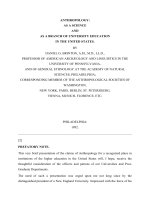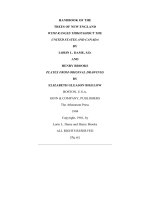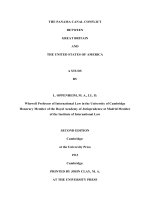The Civil-Military Gap in the United States - Does It Exist, Why, and Does It Matter ppt
Bạn đang xem bản rút gọn của tài liệu. Xem và tải ngay bản đầy đủ của tài liệu tại đây (999.68 KB, 201 trang )
This document and trademark(s) contained herein are protected by law as indicated
in a notice appearing later in this work. This electronic representation of RAND
intellectual property is provided for non-commercial use only. Unauthorized
posting of RAND PDFs to a non-RAND Web site is prohibited. RAND PDFs are
protected under copyright law. Permission is required from RAND to reproduce,
or reuse in another form, any of our research documents for commercial use. For
information on reprint and linking permissions, please see RAND Permissions.
Limited Electronic Distribution Rights
Visit RAND at www.rand.org
Explore RAND Arroyo Center
View document details
For More Information
This PDF document was made available
from www.rand.org as a public service of
the RAND Corporation.
6
Jump down to document
THE ARTS
CHILD POLICY
CIVIL JUSTICE
EDUCATION
ENERGY AND ENVIRONMENT
HEALTH AND HEALTH CARE
INTERNATIONAL AFFAIRS
NATIONAL SECURITY
POPULATION AND AGING
PUBLIC SAFETY
SCIENCE AND TECHNOLOGY
SUBSTANCE ABUSE
TERRORISM AND
HOMELAND SECURITY
TRANSPORTATION AND
INFRASTRUCTURE
WORKFORCE AND WORKPLACE
The RAND Corporation is a nonprofit
research organization providing
objective analysis and effective
solutions that address the challenges
facing the public and private sectors
around the world.
Purchase this document
Browse Books & Publications
Make a charitable contribution
Support RAND
This product is part of the RAND Corporation monograph series.
RAND monographs present major research findings that address the
challenges facing the public and private sectors. All RAND mono-
graphs undergo rigorous peer review to ensure high standards for
research quality and objectivity.
Thomas S. Szayna, Kevin F. McCarthy, Jerry M. Sollinger,
Linda J. Demaine, Jefferson P. Marquis, Brett Steele
Prepared for the United States Army
Approved for public release; distribution unlimited
The Civil-Military Gap
in the United States
Does It Exist, Why, and Does It Matter?
The RAND Corporation is a nonprofit research organization providing
objective analysis and effective solutions that address the challenges
facing the public and private sectors around the world. RAND’s
publications do not necessarily reflect the opinions of its research clients
and sponsors.
R
®
is a registered trademark.
© Copyright 2007 RAND Corporation
All rights reserved. No part of this book may be reproduced in any
form by any electronic or mechanical means (including photocopying,
recording, or information storage and retrieval) without permission in
writing from RAND.
Published 2007 by the RAND Corporation
1776 Main Street, P.O. Box 2138, Santa Monica, CA 90407-2138
1200 South Hayes Street, Arlington, VA 22202-5050
4570 Fifth Avenue, Suite 600, Pittsburgh, PA 15213-2665
RAND URL:
To order RAND documents or to obtain additional information, contact
Distribution Services: Telephone: (310) 451-7002;
Fax: (310) 451-6915; Email:
Library of Congress Cataloging-in-Publication Data
The civil-military gap in the United States : does it exist, why, and does it matter? /
Thomas S. Szayna [et al.].
p. cm.
Includes bibliographical references.
ISBN 978-0-8330-4157-9 (pbk. : alk. paper)
1. Civil-military relations—United States. 2. United States—Armed Forces—
Public opinion. 3. United States—Military policy. 4. Sociology, Military—United
States. I. Szayna, Thomas S., date. II. Title.
UA23.C555 2007
322'.50973—dc22
2007010935
The research described in this report was sponsored by the United States
Army under Contract No. DASW01-01-C-0003. The views expressed in
this report are those of the authors and do not reflect the official policy
or position of the Department of Defense or the U.S. Government.
iii
Preface
is report documents the results of a project entitled “e Army and
the American People.” e project aimed to discern the existence of
any civil-military gaps that might affect the Army’s effectiveness.
e research reported here was sponsored by the Office of the
Deputy Chief of Staff, G-3, Headquarters, Department of the Army.
e research was conducted in RAND Arroyo Center’s Strategy, Doc-
trine, and Resources Program. RAND Arroyo Center, part of the
RAND Corporation, is a federally funded research and development
center sponsored by the United States Army. e report includes infor-
mation that was available to the authors as of early 2005. e report
was approved for public release in February 2007.
is report should be of interest to those concerned with civil-mil-
itary relations in the United States and their impact on military effec-
tiveness. Kevin McCarthy and omas Szayna are the lead authors.
e order of placement of their names was determined by a coin toss.
For comments or further information, please contact either of them:
omas Szayna (telephone 310-393-0411, extension 7758, omas_
); Kevin McCarthy (telephone 310-393-0411, exten-
sion 6919, ).
e Project Unique Identification Code (PUIC) for the project
that produced this document is DAPRRW008.
The views expressed in this report are those of the authors and do not reflect the official
policy or position of the Department of Defense or the U.S. Government.
iv The Civil-Military Gap in the United States
For more information on RAND Arroyo Center, contact the
Director of Operations (telephone 310-393-0411, extension 6419; FAX
310-451-6952; email ), or visit Arroyo’s Web
site at />v
Contents
Preface iii
Figures
ix
Tables
xi
Summary
xiii
Acknowledgments
xix
Acronyms
xxi
CHAPTER ONE
Introduction 1
e Context
1
Objectives and Organization
9
CHAPTER TWO
Toward a Framework for inking About Civil-Military
Relations and Military Effectiveness
13
Background
13
Central Premises of Our Approach
14
Context
15
Civilian Control
15
DoD Missions
16
e Institutional Environment
17
e Policymaking Process
20
Characteristics of the Policymaking Process
20
Key Steps in the Policymaking Process
23
Key Problems Affecting the Policymaking Process
24
Sources of Problems in the Policymaking Process
26
vi The Civil-Military Gap in the United States
Realms of Potential Civil-Military Disagreement 30
reat Assessment
32
Defense Resources
34
Force Design and Creation
36
Force Maintenance
39
Force Employment
41
Summing Up
43
CHAPTER THREE
e TISS Data 45
Introduction
45
Sample Design
46
Population
46
Sampling Frame
48
Methodological Issues at Affect Analytic Conclusions
50
Response Rates
50
Representativeness of the Sample
55
Comparability of the Survey Administration
60
Our Use of the TISS Data
63
CHAPTER FOUR
How Do the Military and Civilians Differ? 65
Introduction
65
Analytical Model
66
Components of Model
70
Empirical Findings
79
Socio-Demographic Profile
79
Political Characteristics
81
Knowledge of and Confidence in the Military
86
View of Domestic Issues
90
Views of International Affairs
95
Discussion of Results
101
CHAPTER FIVE
Military and Civilian Perspectives 105
Introduction
105
Analytical Framework 105
Civilian Control
106
Military Effectiveness
108
reat Assessment
108
Defense Resources
110
Force Design and Creation
111
Force Maintenance
113
Force Employment
114
Research Approach
116
Results
116
reat Assessment
116
Defense Resources
123
Force Design and Creation
129
Force Maintenance
136
Force Employment
141
Civilian Control
145
Discussion of Results
148
CHAPTER SIX
Conclusions and Observations on Future U.S. Civil-Military
Relations
151
Findings
152
Caveats
153
e Current Security Environment
154
Political Environment
155
Some Projections for the Future
156
Future Directions for Research
157
Final Observations
158
APPENDIX
Civilian and Military Elites 161
Bibliography
171
Contents vii
ix
Figures
4.1. Analytical Model for Stage 1 of Analysis 69
xi
Tables
2.1. Realms of Potential Civil-Military Divergence and
eir Impact
32
3.1. Sample Sizes and Response Rates by Subgroup
52
3.2. Comparison of Survey and Completed Surveys Population
by Subsample
54
3.3. Comparison of Selected Characteristics of Population
Completing Survey with Actual Military Population
57
4.1. Comparison of Demographic Characteristics
80
4.2. Party Identification by Military Status
81
4.3. Political Ideology by Military Status
83
4.4. Ideological Orientation by Party Identification and
Military Status
84
4.5. Interest in Military Affairs
86
4.6. Regression Results for Interest in Military Affairs
87
4.7. Confidence in Military by Military Status
89
4.8. Regression of Confidence in Military
90
4.9. Attitudes Toward Domestic Policy Issues by Military Status
91
4.10. Regression of Attitude Toward Domestic Policy
93
4.11. Average Scores on Foreign Policy Scales by Military Status
97
4.12. Regression on Foreign Policy Measures
99
5.1. reat Assessment Measures by Military Status
118
5.2. Regression Results for reat Assessment Variables
120
5.3. Defense Resources Measures by Military Status
125
5.4. Regression Results for Defense Resources Variables
126
5.5. Force Design and Creation Measures by Military Status
130
5.6. Regression Results for Force Design and Creation
132
5.7. Force Maintenance Measures by Military Status
137
xii The Civil-Military Gap in the United States
5.8. Regression Results for Force Maintenance 139
5.9. Force Employment Measures by Military Status
142
5.10. Regression Results for Force Employment
143
5.11. Adherence to Civilian Control by Military Status
(Percent Agree Military Rather than Political Goals
Should Govern Use of Force)
146
5.12. Regression Results for Civilian Control
147
A.1. Military and Civilian Employees at DoD (February 2003)
162
A.2. Civil Service Personnel in DoD
164
A.3. Flag Officers in DoD
166
A.4. Field Grade Officers in Military Services
167
xiii
Summary
During the 1990s, many observers expressed concerns about the state
of civilian-military relations in the United States. Although the expres-
sion of these concerns was muted in the immediate aftermath of the
attacks on 9/11, the underlying issues they raised remain salient. Spe-
cifically, there is a potential for a civil-military gap to undermine mili-
tary effectiveness by reducing support for defense budgets, increasing
the difficulties of recruiting quality people to join the military, and
dwindling public support for using military force, particularly where
high casualties are likely. Some observers even worried that a growing
civilian-military gap could undermine the principle of civilian control
of the military.
e armed services have an abiding interest in preventing prob-
lems that may reduce military effectiveness. Potential problems with
resource availability and with recruitment and retention of personnel
are basic concerns of the services, because they relate directly to tasks
specified in Title 10 of the U.S. Code. Consequently, the Army asked
RAND Arroyo Center to examine the evidence on the existence of a
civil-military gap to determine how it might affect military effective-
ness, what implications it might have on the U.S. actions to deal with
trans-national terrorist groups, and, finally, to recommend actions that
might close any breach that might exist.
e starting premise for our analysis is that the direct and most
important consequences of a civil-military gap for military effective-
ness arise when major differences exist between military and civilian
elites. We justify and explain this premise by proposing an analytical
framework that assumes that the effectiveness of the military is largely
xiv The Civil-Military Gap in the United States
shaped by the characteristics (size, force structure, armaments, man-
ning, and training) that are outputs of the military planning process.
is process is a highly technical one and thus largely driven by military
and civilian experts. Moreover, it consists of a series of steps or stages
that determine such issues as the nature of the threat, the resources
and capabilities needed to meet that threat, the manpower the military
requires, and the way the military is employed. By and large, these
issues are beyond the expertise of all but the experts. When there are
disagreements among the experts—and these disagreements may form
largely along civilian and military lines—the experts will attempt to
win support from other actors involved in the national defense policy
process and/or the general public.
Based on this framework, our analysis then compares the char-
acteristics of military and civilian respondents using a survey put
together by a team of researchers associated with the Triangle Institute
for Security Studies (TISS). Although dated (it was collected prior to
9/11) and somewhat limited in terms of its applicability to our analy-
sis, the TISS data are the most comprehensive data available dealing
with civilian-military attitudes, characteristics, and beliefs. Our analy-
sis proceeds in two stages: first, we compare the military and civilian
respondents in terms of their socio-demographic and political charac-
teristics, their knowledge of and confidence in the military, and their
attitudes toward a broad range of foreign policy and domestic issues.
Second, we examine how military status and the various characteristics
examined in the first analytical step influence the various measures of
military effectiveness and support for the principle of civilian control of
the military. Both stages of our analysis compare four groups: military
officers, military cadets, civilians who formerly served in the military,
and civilian nonveterans.
Findings
ere are a variety of differences between the military and civil-
ian respondents to the TISS survey. Many of these differences were
expected. e military respondents, for example, are younger, much
Summary xv
more likely to be male, and somewhat more likely to be minorities
than the civilian respondents. ey are also more likely to identify
themselves as Republicans and conservatives. However, these differ-
ences appear to have been exacerbated by the specific character of the
TISS sample, which over-represents mid-to-senior level officers as well
as civilians who are well established in their careers. In addition, both
the civilians and military officers in this sample appear to be signifi-
cantly more likely to identify with the Republican Party and to assert a
more conservative ideology than the population as a whole.
Similarly, we found that the military respondents were signifi-
cantly more likely to follow military affairs and to have more confi-
dence in the military as an institution than the civilians—although
each of the four groups used in our comparisons expressed high levels
of confidence in the military. In contrast, we found only minor differ-
ences in the foreign policy views of the four groups. However, military
officers tended to take more conservative positions on domestic policy
issues.
When we focused on how these four groups differed on the issues
related to civilian control of the military and the various measures
influencing military effectiveness, most of the differences among the
groups disappeared. e major exception to this pattern related to such
military personnel policies as women in combat, the military’s policies
with regard to sexual harassment, and whether gays should serve in the
military. ese differences appear to be largely a byproduct of the fact
that the respondents’ attitudes toward military personnel policies are
significantly influenced by their views on domestic social issues. us,
military officers (and cadets) who are more conservative on social issues
than civilians, particularly those civilians who have no experience in
the military, also differ from their civilian counterparts on personnel
issues.
In contrast, most of the other measures of military effectiveness
appear to be influenced more by views of the military threat facing the
country and views of foreign policy—where military officers and civil-
ians share similar perspectives. Finally, concerns about the essential
principle of civilian control of the military appear to be overstated. In
xvi The Civil-Military Gap in the United States
fact, military officers are significantly more likely to express agreement
with this principle than any of the other four groups.
Conclusions and Observations
1
Since the data used for this analysis were collected during the Clinton
administration prior to the election of a Republican, George W. Bush,
and the changes in the security environment that resulted from the
attacks of 9/11 and the military operations in Afghanistan and Iraq,
the question naturally arises of how these developments have affected
the relevance of our findings. e initial impact of the 9/11 attacks
appears to have had strong unifying effects on the country, includ-
ing boosting support for defense budgets and pre-emptive use of force
against trans-national terrorist groups. At the time of the completion
of this report, public support for the war in Iraq had decreased but
remained higher than the relatively low support for the discretionary
military operations undertaken during the 1990s.
e disproportionate identification of military officers with the
Republican Party raised concerns about the potential politicization
of defense issues. However, it appears that policy differences between
civilians and military hinge more on perceived differences due to occu-
pational and professional interests than party identification per se. We
suspect that the most likely catalyst for elite-level civil-military differ-
ences surrounding the defense planning process is the election cycle,
since it raises the possibility of periodic changes in the composition
and policies of elite civilian leadership within the Defense Department.
Uncertainty over core occupational and professional interests may lead
to tensions.
Finally, returning to the three specific goals of the project, we con-
clude the following. First, the military and civilian elites do not differ
1
e main phase of the research and analysis for the project began in the fall of 2001
and ended in the fall of 2002. A draft report was published in April 2004. e report was
reviewed, revised, and updated selectively in late 2004 and early 2005, and it was approved
for public release in February 2007. e report includes information that was available to the
authors as of early 2005.
Summary xvii
greatly on the questions that are of most concern to the Army with one
exception: certain military personnel policies. Second, with regard to
the implications of a potential civil-military gap on the Army’s opera-
tions to deal with trans-national terrorist groups, we find little cause for
concern. e military and civilian elites (as well as the general public)
are united in viewing trans-national terrorism as the primary secu-
rity threat. Nonetheless, some differences may arise in terms of force
employment tactics. e rise of different perceptions toward military
operations in Iraq (both in terms of direct support for these operations
as well as the linkage between the operations in Iraq and the opera-
tions against trans-national terrorist groups) are a potential unknown
and are worthy of following closely. Finally, given the absence of any
major threat to the principle of civilian control and with one exception
(personnel policies) any clear impact of civilian-military divergences on
military effectiveness, we see no need for any special policies that the
Army should consider at this time.
xix
Acknowledgments
e authors are grateful to GEN John M. Keane for interest in the topic,
to MG John R. Wood for sponsoring the research, and to COL Paul D.
Hughes and COL James Boling for being the project monitors.
e authors are also grateful to the TISS team for their time and
willingness to discuss their work. We are especially grateful to Peter
Feaver for providing us with the survey data.
We appreciate the thoughtful reviews of an earlier version of this
study by John Mueller (Ohio State University), Don M. Snider (U.S.
Army Military Academy), and John Adams (RAND). We are also
grateful to Deborah Avant (George Washington University) for com-
menting on the document.
At RAND, omas McNaugher, David Kassing, and Lauri
Zeman provided support and encouragement throughout the project’s
duration and beyond. Sally Morton and Susan Gates were especially
helpful in the course of the research. Laura Miller spent a generous
amount of time with the authors going over the findings. Yuna Huh
and Bogdan Savych assisted in the analysis of the data. Lisa Lewis,
Pamela ompson, and Terri Perkins provided administrative assis-
tance and helped in the formatting of the document. Nikki Shacklett
edited the document.
The views expressed in this report are those of the authors and do not reflect the official
policy or position of the Department of Defense or the U.S. Government.
xxi
Acronyms
APGM Army Program Guidance Memorandum
ASPG Army Strategic Planning Guidance
DoD Department of Defense
DPG Defense Planning Guidance
JPD Joint Planning Document
JSCP Joint Strategic Capabilities Plan
NDU National Defense University
NMS National Military Strategy
POM Program Objective Memorandum
RDA Research Development and Acquisition
ROTC Reserve Officer Training Corps
SES Senior Executive Service
TISS Triangle Institute for Security Studies
1
CHAPTER ONE
Introduction
The Context
During the 1990s, some journalists and academics voiced concern
about the state of civilian-military relations in the United States. eir
concerns focused on the potential emergence of a growing gap between
the characteristics, attitudes, and beliefs of the military and civilian
society.
1
In the words of a U.S. Navy officer, “[the] perceived [civil-mil-
1
e academic journal of the Inter-University Seminar on Armed Forces and Society, Armed
Forces & Society, and a wide-circulation policy journal, e National Interest, were some of the
main venues for the debate. A partial list of the more notable contributions includes the fol-
lowing: Charles J. Dunlap Jr., “e Origins of the American Military Coup of 2012,” Param-
eters, 22:4 (1992–93), 2–20; Russell F. Weigley, “e American Military and the Principle of
Civilian Control from McClellan to Powell,” Journal of Military History, 57:5 (1993), 27–58;
Richard H. Kohn, “Out of Control: e Crisis of Civil-Military Relations,” e National
Interest, 35 (1994), 3–17; Charles J. Dunlap, Jr., “Welcome to the Junta: e Erosion of Civil-
ian Control of the U.S. Military,” Wake Forest Law Review, 29:2 (1994), 341–392; Eliot A.
Cohen, “Playing Powell Politics: e General’s Zest for Power,” Foreign Affairs, 74 (1995),
102–110; Don M. Snider and Miranda A. Carlton-Carew (eds.), U.S. Civil-Military Rela-
tions: In Crisis or Transition?, Washington, D.C.: e Center for Strategic & International
Studies, 1995; Deborah Avant, “Are the Reluctant Warriors Out of Control? Why the U.S.
Military Is Averse to Responding to Post–Cold War Low-Level reats,” Security Studies, 6:2
(1996–97), 51–90; Armed Forces & Society, 24:3 (1998), “A Symposium on Civil-Military
Relations,” which included articles by Deborah Avant, “Conflicting Indicators of ‘Crisis’ in
American Civil-Military Relations,” Michael C. Desch, “Soldiers, States, and Structures: e
End of the Cold War and Weakening of U.S. Civilian Control,” Peter Feaver, “Crisis as Shirk-
ing: An Agency eory Explanation of the Souring of American Civil-Military Relations,”
Cori Dauber, “e Practice of Argument: Reading the Condition of Civil-Military Rela-
tions,” Andrew J. Bacevich, “Absent History: A Comment on Dauber, Desch, and Feaver,”
and James Burk, “e Logic of Crisis and Civil-Military Relations eory: A Comment on
Desch, Feaver, and Dauber”; Ole Holsti, “A Widening Gap Between the U.S. Military and









